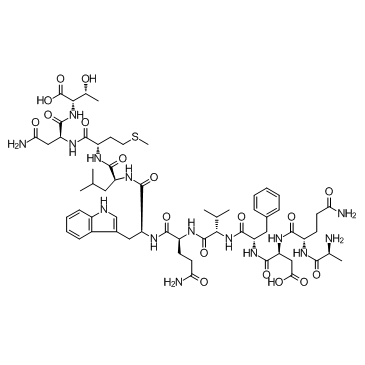Glucagon (19-29) (human, rat, porcine) trifluoroacetate salt
Modify Date: 2025-08-25 20:50:20

Glucagon (19-29) (human, rat, porcine) trifluoroacetate salt structure
|
Common Name | Glucagon (19-29) (human, rat, porcine) trifluoroacetate salt | ||
|---|---|---|---|---|
| CAS Number | 64790-15-4 | Molecular Weight | 1352.51000 | |
| Density | 1.339 g/cm3 | Boiling Point | 1828.5ºC at 760 mmHg | |
| Molecular Formula | C61H89N15O18S | Melting Point | N/A | |
| MSDS | N/A | Flash Point | 1059.6ºC | |
Use of Glucagon (19-29) (human, rat, porcine) trifluoroacetate saltGlucagon (19-29), human is a potent and efficient inhibitor of insulin secretion. |
| Name | h-ala-gln-asp-phe-val-gln-trp-leu-met-asn-thr-oh |
|---|---|
| Synonym | More Synonyms |
| Description | Glucagon (19-29), human is a potent and efficient inhibitor of insulin secretion. |
|---|---|
| Related Catalog | |
| Target |
Insulin secretion[1] |
| In Vitro | Glucagon (19-29), from 0.1 pM to 1 nM, exerts a potent negative inotropic action. The most striking observation is a 45% increase in the amplitude of cell contractility elicited by the combination of 30 nM glucagon with 1 nM Glucagon (19-29)[3]. |
| In Vivo | Glucagon (19-29), also named Miniglucagon, is the COOH-terminal (19-29) fragment processed from glucagon. Glucagon (19-29) dose-dependently inhibits insulin secretion stimulated by 8.3 M glucose, with no change in the perfusion flow rate. A concentration of 1 nM Glucagon (19-29) has a significant inhibitory effect on a 1 nM glucagon-like peptide 1 (7-36) amide–potentiated insulin secretion[1]. Glucagon (19-29) is a highly potent and efficient inhibitor of insulin release by closing, via hyperpolarization, voltage-dependent Ca2+ channels linked to a pathway involving a pertussis toxin-sensitive G protein[2]. |
| Animal Admin | Rats[1] To test the effect of miniglucagon (Glucagon (19-29)) on stimulated insulin secretion, 8.3 mM glucose is perfused during the experiments, including a 45-min equilibration period, followed by miniglucagon (1, 10, 100, and 1,000 pM) perfused with or without 1 nM tGLP-1. To study the glucagon and miniglucagon secretion, the glucose concentration is switched from 11 to 3 mM after a 45-min stabilization period, and the peptides secreted are measured by radioimmunoassay[1]. |
| References |
| Density | 1.339 g/cm3 |
|---|---|
| Boiling Point | 1828.5ºC at 760 mmHg |
| Molecular Formula | C61H89N15O18S |
| Molecular Weight | 1352.51000 |
| Flash Point | 1059.6ºC |
| Exact Mass | 1351.62000 |
| PSA | 582.21000 |
| LogP | 2.66020 |
| Index of Refraction | 1.596 |
| InChIKey | SVHJFTNFNMWDBS-FPLSMPAJSA-N |
| SMILES | CSCCC(NC(=O)C(CC(C)C)NC(=O)C(Cc1c[nH]c2ccccc12)NC(=O)C(CCC(N)=O)NC(=O)C(NC(=O)C(Cc1ccccc1)NC(=O)C(CC(=O)O)NC(=O)C(CCC(N)=O)NC(=O)C(C)N)C(C)C)C(=O)NC(CC(N)=O)C(=O)NC(C(=O)O)C(C)O |
| Miniglucagon (huMan,rat,porcine) |
| Glucagon (19-29) (human,rat,porcine) |
| GLUCAGON (19-29),HUMAN |
| AQDFVQWLMNT |
| glucagon(19-29 |
| Glucagon (19-29) (huMan,rat,porcine) Miniglucagon (huMan,rat,porcine) |
| ALA-GLN-ASP-PHE-VAL-GLN-TRP-LEU-MET-ASN-THR |
| GLUCAGON (19-29),BOVINE,HUMAN,PORCINE |
| GLUCAGON (19-29) (HUMAN,BOVINE,PORCINE) |
| Glucagon (19-29), human |

